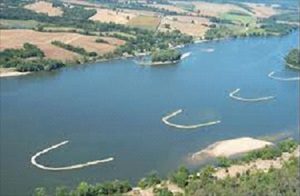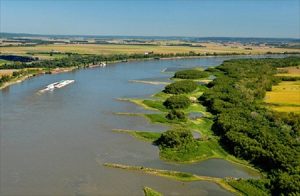River structures magnify flood risks and harm the environment

For more than a century, the U.S. Army Corps of Engineers has been wrestling with the Mighty Mississippi, determined to “train” it. The goal, per several acts of Congress, is to maintain a nine foot deep channel between Minneapolis and St. Louis. Barges need this depth to safely navigate the river. The Corps has taken this mandate very seriously, constructing thousands of river training structures in the Upper Mississippi River-Illinois Waterway navigation system.
These training structures maintain a navigable channel by harnessing the forces of water and sediment in the river and directing them into the navigation channel where they scour the river bottom and deepen the channel. This allows barges to travel the river throughout the year, even when the river is low.
But what’s good for navigation is not so great for the rest of us. More than two decades of research has demonstrated that river training structures threaten people, fish and wildlife. While river training structures may lower immediate dredging costs, the harms they cause are (literally) pushed onto others.
The most commonly used river training structures are wing dikes, bendway weirs, and chevrons. Though darlings of the Army Corps, they cause great damage and increase flood risks. River training structures act as speed bumps in the river. Water stacks up behind them, raising flood heights by as much as six meters in some areas of Illinois. Data collected by the National Science Foundation suggest that the Army Corps’ training structures are the primary reason we are seeing bigger and more frequent floods in the Upper Mississippi.

According to the US Geological Survey, the Corps’ management of the Upper Mississippi River System, including the wide use of river training structures, is destroying critical river habitat like backwaters, side channels and wetlands, and is causing nonnative species to proliferate. The Corps’ mismanagement has resulted in a substantial loss of habitat diversity.
The loss of habitat has been particularly hard on endangered and threatened species. According to the US Fish and Wildlife Service, the Corps’ navigation system threatens the Higgins eye pearly mussel, the pallid sturgeon, the least tern, the winged mapleleaf mussel, the bald eagle, the Indiana bat, and the decurrent false aster.
It is time for us to develop a healthier living and working relationship with the Mississippi River. For too long narrow business interests have determined how the River is managed. Those interests have accrued substantial benefits, while riverside property owners, the taxpayer, and the public at large have paid a very high price. We have lost untold dollars and resources as flooding becomes increasingly more severe, fish populations that once supported huge commercial fisheries have dwindled, and the river’s natural ability to moderate floods and absorb pollution have been lost.

Prairie Rivers Network has joined with other river groups in calling for a National Academy of Sciences study on the impacts of river training structures and a moratorium on the building of new ones while the study is completed. We’re working to secure a new way of tending the river that makes it safe for all of us: people, fish and wildlife.
(Updated 4/16/2018)







